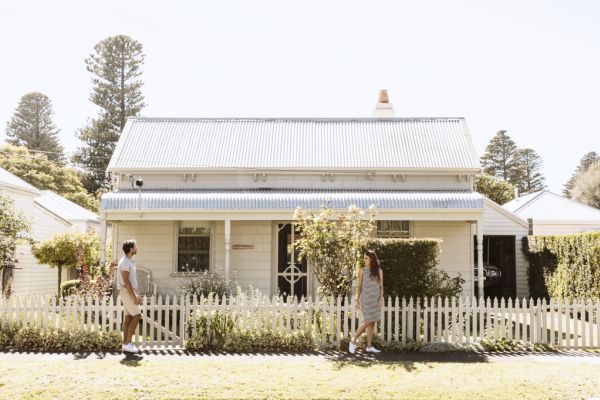
How to make an inherited garden your own
When you purchase an established property, you’re not only buying someone else’s home but someone else’s garden, too. Whether the previous owners have left it a catastrophic mess or well-manicured but not your style, there will be work to be done to put your own stamp on it.
Making an inherited garden work for you takes skill and know-how. We asked two leading landscapers for everything the keen DIYer needs to know to make a garden their own. Gloves are on, and secateurs poised …
Clear and declutter
“Most homebuyers don’t inherit a beautifully manicured garden,” says Darin Bradbury, senior designer at Mint Design. “Often, it’s overgrown, so it can be challenging to get a proper feel for a space.”
Start by clearing rubbish, old infrastructure and weeds so you can access what you have left to work with. “Consider removing trees that are in poor health or present risk,” suggests landscape architect Phillip Withers. “Don’t be afraid to remove some unwanted exotic plants either.”
Understand soil and site
Identify your soil type before you choose your plants. Photo: Alex Carlyle
Identifying your soil type is simple using a pH soil testing kit found in most garden centres. Knowing what you are working with affects the types of plants you choose, and the soil’s texture and consistency are vital for gauging the level of nutrition and drainage they require to thrive.
“Generally, our soils aren’t great quality,” Bradbury says. “Before topping up your site with fresh soil, remove the existing top layer [between 100 and 150 millimetres] to eliminate the seed bank of weeds. Otherwise, they just keep growing!”
Identify plants
Engage a horticulturist or respected garden maintenance person to help identify plant species and, if needed, engage an arborist to determine the health of any existing trees. “Research local ecological vegetation classes [EVCs] to understand the indigenous plant life in your garden,” Withers suggests. “It can guide your choices around local plant life when making selections, which helps connect your garden back to the borrowed landscape.”
Bradbury agrees and says removing the wrong tree can prove disastrous. “It’s not about whether a tree is beautiful; it’s whether it’s performing a good function for your property,” he says. “It might provide shade, privacy or block out the neighbouring three-storey apartment building. Seeking expert help costs money, but it’s worth it.”
Plan, plot and design
Garden in Essendon by Mint Garden Design. Photo: Dave Kulesza
Flick through books and magazines and walk around your neighbourhood to find inspiration for the look, feel and functionality of your space. “It’s helpful to have a vision of how you’d like to feel there,” Withers says. “Start with your most important elements, like the fire pit and dining areas, and let the vegetation form around and within these spaces.”
A considered design guides your process and ensures cohesiveness. “Without a plan, you may plant out a dark shady corner one weekend, then six months later the sunny area of your garden, creating a discontinuity,” Bradbury says. “A well-thought-out plan keeps you on track.”
Pick your plants
Choose a range of diverse species for a beautiful space and healthy physical environment. “A combination of native plants, flowers, trees, grasses and ground cover with varied blooming times creates a functioning eco-system,” Withers says. “You can add in exotics where desired.”
The site’s aspects and conditions also impact which plants go where. “Think about wet areas, shady spots and full sun areas and consult with an expert about what species work well in these areas,” Bradbury says.
Plant your garden
The size of your garden determines how large the job will be to create it. “If it’s a small courtyard, it’s simple, but a larger garden can require hundreds of plants,” Bradbury says. “It’s hard work!”
If planting yourself, “compose” your plants, placing them in their pots around the garden, making sure there is enough space around them for growth.
“Remember every plant has a more attractive side, so it’s important it faces where it will be viewed from,” Bradbury says. “Ensure you fill each plant bed generously rather than spread them out. Once happy, remove the plants from their pots, push each pot down to make a circular hole, and plant away.”
Otherwise, engage a landscaper to help you. “It’s worth having a landscape contractor onsite to help you build the garden,” Withers says. “It’s important to be involved and learn about your garden as you start to take on the responsibility of caring for it post-installation.”
Care and nourish
Install a convenient irrigation system, or hand-water early in the mornings or later in the afternoon when the roots can absorb more water and the sun won’t sap away moisture. Fertilise regularly and prune when needed. Eliminating weeds by hand is the most effective method. If left to mature, they develop seed heads, making them even more persistent.
Otherwise, work smarter rather than harder and employ help like a local garden expert or qualified horticulture team. “They help perform routine maintenance with you, or undertake all of it if you just want to enjoy your garden,” Withers says. “[Gardening] is a pleasurable task to take on. The more you put into your garden, the more you’ll get out.”
Domain reports




